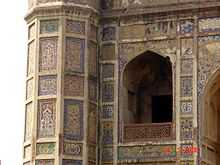Chauburji
| Chauburji | |
|---|---|
|
Chauburji, gateway to the erstwhile Garden of Zeb-un-nisa. | |
| Basic information | |
| Location | Lahore, Pakistan |
| Affiliation | Islam |
| Architectural style | Islamic architecture |
| Completed | 1646 A.D (1056 A.H) |
| Minaret(s) | 4 |


Chauburji (Urdu: چو برجی) (Chau meaning four, burji meaning tower) is one of the most famous monuments among the structures and buildings of the Mughal era in the city of Lahore, Punjab, Pakistan.
In the historic city of Lahore, on the road that led southwards to Multan, the Chauburji gateway remains of an extensive garden known to have existed in Mughal times. The establishment of this garden is attributed to Mughal Princess Zeb-un-Nisa, 1646 AD, which appears in one of the inscriptions on the gateway. The gateway consists of four towers and contains much of the brilliant tile work with which the entire entrance was once covered.
Architecture
Chauburji represents a strong blend of Mughal architecture with ancient Muslim style of building. Its distinguishing features are the minarets which expand from the top, not present anywhere in the sub-continent. Some, however, believe that there were cupolas upon these minarets which collapsed with the passage of time. Arches are of the so-called 'Tudor' style, adapted to Islamic architecture, particularly in Mughal mausoleums and mosques. The red brickwork is typical of the Muslim buildings of the sub-continent; the doorways and windows running through the interior corridors are examples of the living style that characterised the Mughal buildings. However, the main purpose of building Chauburji appears to be strictly monumental. The decrepit building, which has not lost its elegance, stands alone surrounded by hoardings and bustling traffic on the busy Multan Road.
Resemblance to Charminar of Hyderabad
Dr. Ajaz Anwar wrote in an article published in The Pakistan Times in April 1985: “But the real prototype of Chauburji is the Charminar (meaning: four minarets) of Hyderabad Deccan constructed in 1591 by Muhammad Quli as a triumphal arch at the junction of four roads, leading to the four quarters of the old city. Octagonal minarets were later used along the corners of the Tomb of Jahangir itself. This became a motif and was incorporated in the Taj where the minarets flank the corners of the platform... The Charminar, though it comes closest to Chauburji, has a striking contrast and a sense of negation between the very simple lower portion and the heavily decorated upper portion. In the tomb of Akbar, the white marble and variegated stone give the feeling of having been added later... Chauburji, because of the colour of the brick adorned with glazed tiles having the look of flowering creepers, retains a distinctive unity.”
Lost Garden of Zeb-un-Nisa

Originally it was gateway to the Garden of Zeb-un-Nisa or Zebinda Begum, the accomplished daughter of Aurangzeb. This garden is believed to have been extended from Nawankot in the south to the main city of Lahore towards north. However, no traces of such an expansive garden are now available. A fragmentary inscription on the eastern archway records that the garden was built in AH. 1056 i.e. 1646 AD.
Although most of the inscriptions have been lost, on the upper-most part of the construction Ayat-ul-Kursi can be seen in Arabic script in blue and worked in porcelain. Others include two couplets written in Persian above the arch:
“This garden, in the pattern of the garden of Paradise, has been founded (missing line)... The garden has been bestowed on Mian Bai. By the bounty of Zebinda Begum, the Lady of the Age."
It is thus understood that it was commissioned by Sahib-e-Zebinda (one endowed with elegance), Begum-e- Dauran (Lady of Ages) and was bestowed upon Mian Bai Fakhrunnisa (Pride of Women), the favourite female attendant of the princess.
Renovation
During a severe earthquake in 1843, the north-western minaret collapsed and cracks appeared in the central arch. This has however been restored as much as was reasonably possible and the gateway now looks quite as it might have been during the time of its Mughal patroness. The restoration was carried out by the Department of Archeology in the late in 1960's.
See also
- Islamic Architecture
- Char Minar
References
External links
| Wikimedia Commons has media related to Chauburji. |
- Watch Chauburji in 3D by using Google Earth. Modeled by Ahsan Iqbal
| ||||||||||||||||||||||||||
| ||||||||||||||||||||||||||
